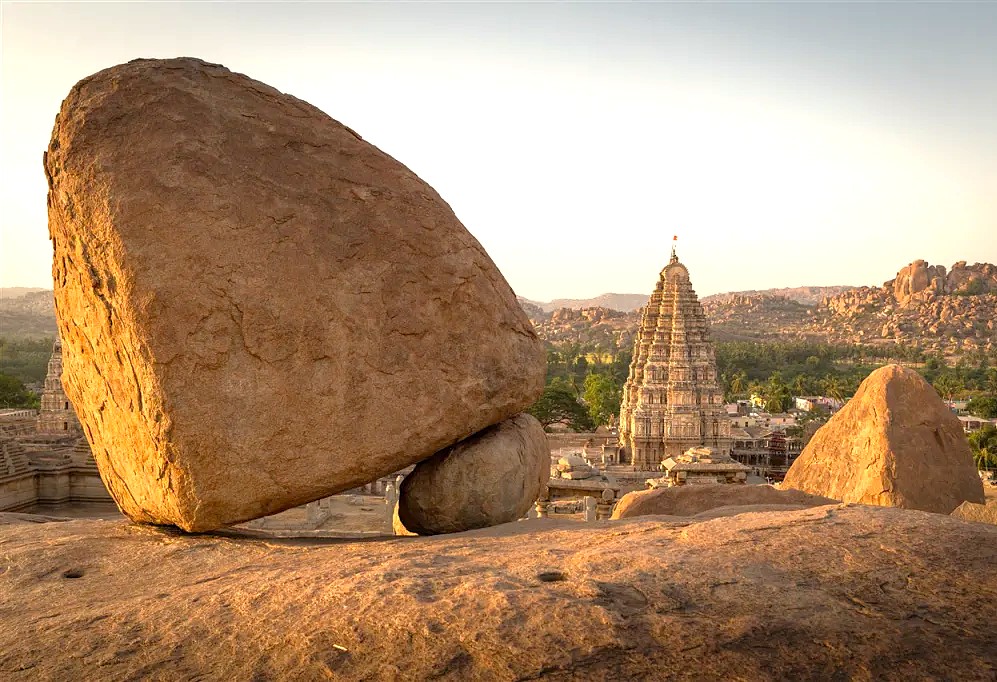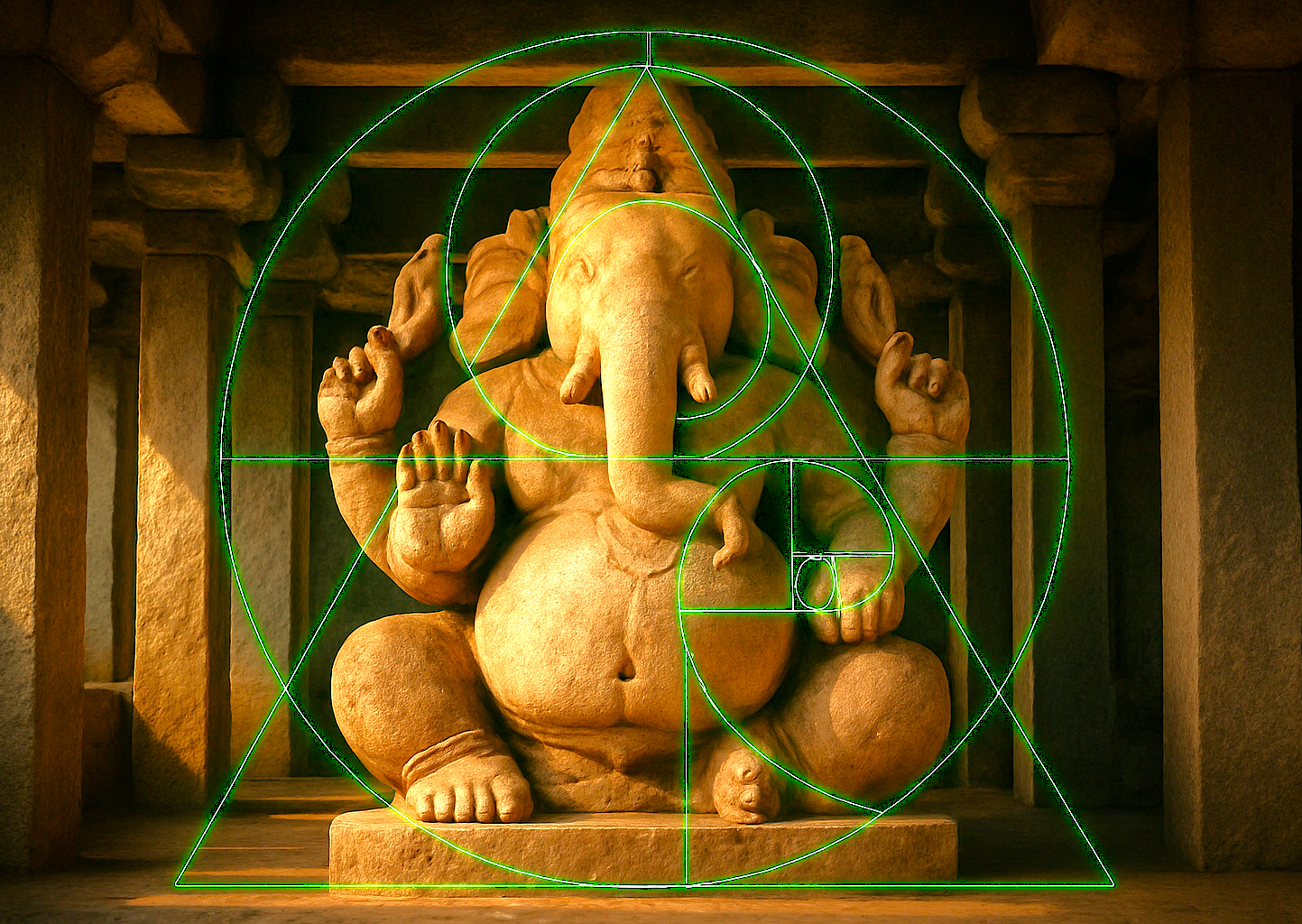Echoes of Ancient Lands
Kadalekalu Sasivekalu Ganesha Hampi India
Mother Masala Tours
Ancient Deities of Vijayanagara
Kadalekalu Sasivekalu Ganesha Hampi India. The twin monolithic Ganesha statues of Kadalekalu and Sasivekalu - stand as eternal guardians of the former Vijayanagara Dynasty capital. Carved from single granite boulders during the empire's zenith, these divine sentinels represent pinnacle achievements of 16th century stone craftsmanship. Located on Hemakuta Hill within the Unesco World Heritage Site, these colossal statues embody Hindu devotion and imperial power. Kadalekalu, resembling a Bengal gram or chickpea, and Sasivekalu, shaped like a mustard seed, continue to attract devotees and history enthusiasts alike, withstanding centuries of climate and conflict.

Kadalekalu Sasivekalu Ganesha Hampi India: Chickpea God
The Ganesha's commands attention with its imposing 4.5-meter height. Meticulously carved from a single granite boulder in 1506 CE, this monolithic masterpiece depicts Ganesha in seated position. Its name "Kadalekalu" derives from the statue's resemblance to a Bengal gram - chickpea. Commissioned by a wealthy chickpea trader to honor his prosperity source, the statue features intricate details despite weathering over five centuries. The statue's right tusk shows damage attributed to the 1565 CE invasion when Vijayanagara fell to the Deccan Sultanates coalition.
Sacred Protector of Ancient Capital

Positioned strategically on Hemakuta Hill's northeastern slope, the sculptures served dual purposes - religious inspiration and imperial protection. According to inscriptions, the statue was sanctified in elaborate ceremonies attended by Emperor Krishnadevaraya himself. Court chronicles record offerings of 108 varieties of food preparations during the consecration ritual. The temple surrounding the statue originally featured a mandapa with sixteen pillars - only partial remains exist today. The position grants spectacular vistas of this sacred landscape, connecting devotees with both the earthly and celestial.
Gold Coins for Divine Blessing's
Kadalekalu Sasivekalu Ganesha Hampi India. Inscriptions reveal the statue's construction was financed by Abhinavatimma, a wealthy Bengal gram merchant from the Vijayanagara capital. His donation, recorded as 40,000 gold coins, represented tremendous wealth equivalent to maintaining 400 cavalry soldiers for one year. The merchant sought divine protection for his trade caravans traversing dangerous routes to distant ports. Historical records indicate Abhinavatimma's lineage continued as respected temple patrons for three generations. The funding illustrates how commercial prosperity directly translated into religious expression during the empire's golden age.
Seasonal Celebrations

The temples follow precise astronomical orientations allowing sunlight to illuminate each statue on specific celestial occasions. During Ganesha Chaturthi held in August-September, the rising sun casts beams directly onto Kadalekalu Ganesha's face. Historical records from court astrologer Tamraparni indicate deliberate alignment with star Pushya - gamma Cancri. Annual celebrations involved precise timing of rituals according to lunar positioning. Court chronicles document how the Vijayanagara calendar precisely recorded festival periods, with celebrations lasting 10 days including dramatic performances by 400 dancers.
Artistic Excellence and Master Craftsmen
Stone inscriptions identify master sculptor Naganna Acharya as the principal artist behind both statues. His signature technique involved initial carving directly on mountainside before final detachment from bedrock. Records indicate 40 artisans worked continuously for 2 years on Kadalekalu Ganesha, consuming 6,000 iron chisels in the process. The finished works demonstrate sophisticated understanding of proportion, weight distribution, and symbolic representation. The sculptural tradition followed strict canonical requirements from Shilpa Shastra texts while incorporating regional stylistic elements unique to Southern Dravidian aesthetics.
Sacred Geometry

Both statues embody core Hindu philosophical concepts through precise geometric relationships. The Kadalekalu Ganesha follows exact proportional ratios described in Brihat Samhita texts - the head comprising one-fourth total height, symbolizing cosmic balance. The surrounding temple incorporates specific numerical elements: 64 ceiling panels representing arts, 16 pillars symbolizing philosophical completeness, and 108 lotus motifs embodying universal wholeness. Records indicate ceremonial measurements using special silver rulers during consecration in 1506 CE, ensuring dimensional accuracy.
The Dieties of Hampi
In Hampi, many deities are worshipped in temples scattered throughout the landscape. One of the most well-known is the stone figure of Kadalekalu Ganesha, sitting with a calm face and gentle posture, offering a sense of steady presence. Stories say Ganesha was made from chickpeas by Parvati, which explains his name here. Nearby, the Virupaksha Temple is dedicated to Shiva, whose symbol stands at the center of the complex, marking the site as sacred for centuries. We come across stories recorded in carvings and old stones, with each image revealing an episode from epic tales. Across every temple, history sits quietly, reminding us that belief can shape stone into a living story.
Pack Your Bags - Let The Adventure Begin

Join with us as we walk the ancient paths of Hemakuta Hill, where monolithic statues remain in view. These stone deities stand out for their size and careful craftsmanship, reflecting the skills of those who worked the rock. You spend time observing the different forms and intricate lines that tell the story of the place. The environment feels simple and calm, with open spaces to pause and take in the area. In the quiet presence of these statues, it becomes clear that even stone can hold and carry the traces of light from every passing age.
Symphony of Generosity: Offerings from Wanderers to Residents
These statues in Hampi attract artists, travelers, and local traditions from many backgrounds. The temples and sculptures offer quiet places where everyone can step aside from busy routines and notice the work of past creators. Each figure, such as Ganesha or Shiva, is linked to a story often shared by regional guides or locals. Visitors see painting, music, and rituals practiced around these sites, keeping older stories present through daily activities. These spaces create small moments of interaction that cut across language or custom. Simple acts of drawing, storytelling, or making offerings reveal shared interests. In the presence of these statues, creativity and tradition meet in ways that make a lasting impression.